One of the most mesmerizing and beautiful things about caring for fish is the unique and intricate patterns that the various species display. What could be more iconic than some striking black bands?
Although we tend to associate them with land animals like tigers and zebras, there are a surprising variety of fish aquarium companions with this particular kind of marking.
Some of these stripes are designed to act as camouflage – breaking up the distinctive shape of the body – others are warning signs, and some even have a social purpose.
Read ahead as we take a look at some of the most popular fish with black stripes that you can find.
Contents
Fish With Black Stripes
More popular posts:
- Fish That Look Like Snakes
- Fish That Look Like a Stingray
- Fish That Look Like Dragon
- Popular Fish With Ugly Teeth
1. Black Banded Leporinus

- Scientific name: Leporinus fasciatus
- Diet: Omnivore
You won’t find many fish that are more clearly striped than this characin. The Black Banded Leporinus has incredibly distinct vertical stripes all down its long body, and it’s this bold pattern that makes them so popular among aquarium enthusiasts.
These fish are active and vibrant, and they can actually jump surprisingly high, so they need a large aquarium. They are pretty peaceful and hardy overall, and usually get on well in a community environment.
Interestingly, you can actually tell how old one of these fish is by counting how many stripes it has. When they are young, they start out with just 5 stripes then, after a year, the bands start to split into two every 6 months. Once they reach around 3 years old, they should have 10 bands in total.
2. Zebra Danio

- Scientific name: Danio rerio
- Diet: Omnivore
These little schooling fish are a great option for beginners as they are inexpensive, easy to care for, and very pretty to look at. There are many different selectively bred varieties of this particular danio, although most of them will have long, thin black stripes that run down the length of their bodies.
If you do want to look after some Zebra Danio, it is worth noting that they are hardy creatures and prolific breeders. You are likely to end up with quite a few more fish than you might have bargained for!
They are actually one of the easiest fish to breed, and they like to be kept in groups of at least 5 individuals.
3. Convict Tang

- Scientific name: Acanthurus triostegus
- Diet: Omnivore
Not the only fish species to be named after the infamous black-and-white striped outfits of convicted prisoners, this particular tang has relatively thin black bands and a pure white body.
Convict Tangs have a lot of personality, which makes them a very vibrant addition to an aquarium, although they are semi-aggressive and can get a little feisty with certain tank mates.
In the wild, they are normally found in large groups, but they are often easier to care for individually if you want to avoid possible altercations.
These saltwater fish like a lot of space to move around in, so they need to be kept in a large reef environment where possible.
4. Black Stripe Dwarf Cichlid

- Scientific name: Taeniacara candidi
- Diet: Omnivore
The clue with these cichlids is all in the name. They have a particularly elongated body that is dominated by one long, black stripe which gives them a very distinctive appearance.
Although they can be challenging to keep, the Black Stripe Dwarf Cichlid is a vibrant and entertaining creature with a lot of personality in a very small package. They only reach just under 3 inches in length, with females typically being even smaller than that.
5. Multibarred Angelfish
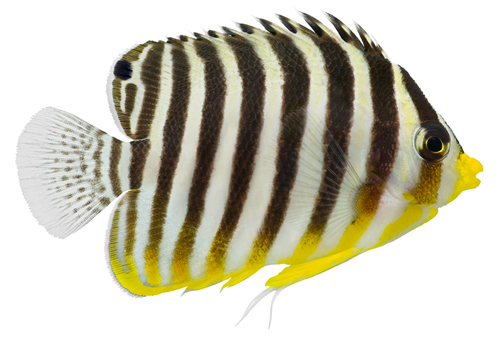
- Scientific name: Paracentropyge multifasciata
- Diet: Omnivore
Some of the most iconic fish with black stripes are, of course, among the many different kinds of angelfish that are much beloved in tropical fish communities.
The Mulibarred Angeflish is one of the most striped of them all, with eight vertical black bands that turn onto a beautifully bright yellow color at the bottom.
Multibarred Angelfish are relatively shy and reclusive, and they need an aged reef tank if they are going to be truly comfortable. They are often kept in a single-species environment, but they do get on well with less aggressive tank mates.
These angelfish like to be in pairs or small groups, and they want a good amount of space to move around in.
6. Black ; White Bandit Angelfish
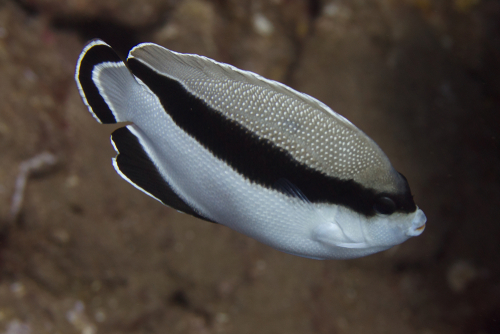
- Scientific name: Holacanthus arcuatus
- Diet: Omnivore
These angelfish have a very descriptive name. They look just like little underwater criminals, with a wide black band wrapped around their faces just like a classic masked bandit from a cartoon.
The Black ; White Bandit Angelfish has an otherwise pearlescent and pale body, although the area above the band is a little bit darker.
These fish tend to need quite a large tank to be truly happy, and they usually get on pretty well with gentle tank mates. They can, however, be a little bit aggressive towards other angelfish species.
Like many angelfish, these bandits love to hide and have quite particular needs when it comes to the quality, temperature, and lighting in their environment.
7. Zebra Angelfish

- Scientific name: Pomacanthus semicirculatus
- Diet: Omnivore
Perhaps the most iconic black-striped fish of them all, the Zebra Angelfish has a beautiful triangular shape and a silver body, of course, marked by the dark vertical stripes that give them their name.
Because they have such high dorsal fins and long, trailing ventral and anal fins, they need to be kept in a tall tank. They like a decent amount of room and want to be able to hide away in rocks and plants, as well as have some open space to move around in.
In the wild, they live in schools and usually prefer to be in a group, although they do tend to pair off and become territorial as they get older.
8. Convict Cichlid
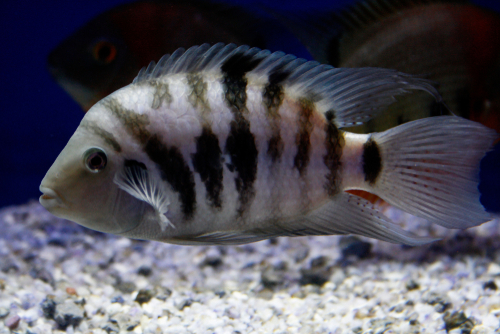
- Scientific name: Archocentrus nigrofasciatus
- Diet: Omnivore
Another fish named after the prison jumpsuits of the past, Convict Cichlids, hail from the lakes, rivers, and streams of Central America – and you can definitely tell the males apart from the females.
They both have 8 or 9 black vertical bars on a grayish body, but males are typically much larger with a large lump on their foreheads and more pointed fins.
These fish love getting involved in interior design, and they are infamous for moving around any objects that are kept in their aquariums. They love a bit of movement in their water as well because their preferred home is in rivers or streams.
9. Tiger Barb
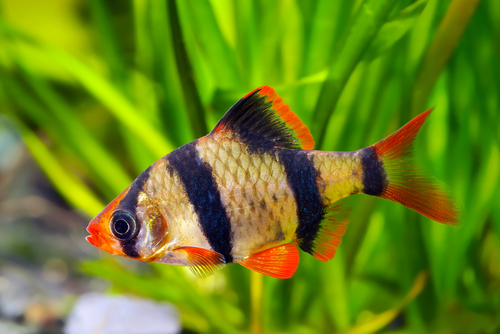
- Scientific name: Barbus tetrazona
- Diet: Omnivore
A native of Borneo and Malaysia, the Tiger Barb is a beautiful, relatively small tropical fish that is not too challenging to care for. As you might expect from their name, they have strong, tiger-like black stripes and a yellowy-orange body.
These barbs can actually handle quite a variety of different water conditions, although they do prefer slightly acidic, soft water. They do need a bit of space and like to have a relatively open area in which to swim as well as plants and rocks that they can hide in.
They can get into disputes with other fish, although they tend to just fight amongst themselves if there are 6 or more barbs in the same tank.
10. Old Wife
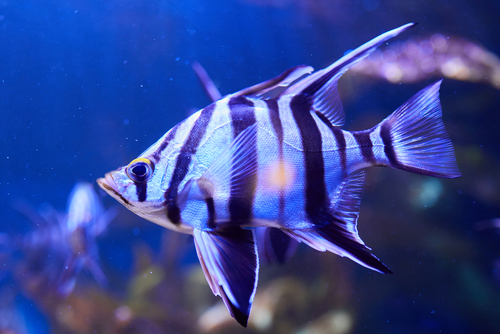
- Scientific name: Enoplosus armatus
- Diet: Carnivore
The slightly curious name of these particular stripy fish is a reference to the sound that they make by grinding their teeth when they are caught on a hook. The Old Wife is a big fish with a rather dramatic appearance: it has two dorsal fins (one of which is curved like a sickle) and a long, wide body.
They have strong black bands that vary in width, spread across a silvery brown body. These fish are peaceful and friendly saltwater carnivores, although their first dorsal fin is actually venomous and can cause a nasty sting.
The Old Wife needs a large aquarium and can be relatively happy by themselves or in small groups.
11. Three Stripe/Four Stripe Damselfish
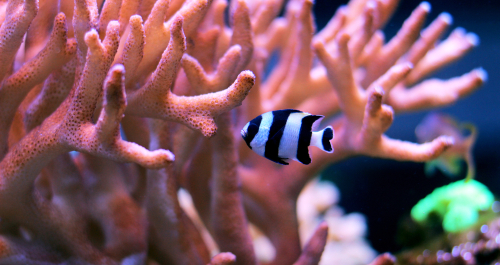
- Scientific name: Dascyllus aruanus/Dascyllus melanurus
- Diet: Omnivore
These wonderful specimens have some very big and bold black stripes. Three Stripe Damselfish and Four Stripe Damselfish are both saltwater species that are popular in aquariums.
As their name suggests, you can tell these two species apart by the number of clear and distinctive stripes that run down the side of their bodies. Originating from the west Pacific Ocean, both of these damselfish make for a striking addition to any tank, but they don’t necessarily play well with others.
They can be quite aggressive and may even bully other fish that they are housed with, and they are also vulnerable to larger predatory species like eels.
12. Striped Raphael Catfish

- Scientific name: Platydoras armatulus
- Diet: Omnivore
For aquarium hobbyists, there are few fish families that are more beloved than the catfish. They are generally interesting, curious, and friendly creatures that are easy to care for: and the Striped Raphael Catfish is no exception. They are even considered to be the nicest of all the Thorny Catfish you can find.
These fish are very dark. They actually have almost black bodies and small white bands that run down their sides, giving the appearance of two wide black stripes from nose to tail.
13. Scissortail Sergeant
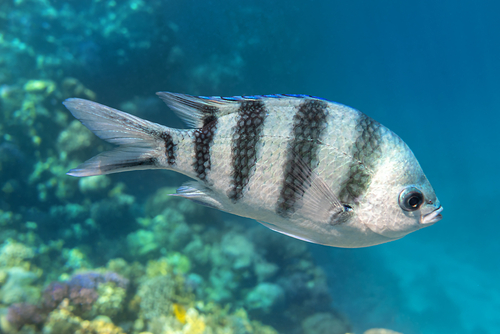
- Scientific name: Abudefduf sexfasciatus
- Diet: Omnivore
These fish are very characteristic and much-loved for their striking appearance, but they also live up to their name. The Scissortail Sergeant is not likely to shy away from a fight, and they can get very aggressive with other members of their tank.
Interestingly, though, it actually owes its name to its striped side and tails, which is similar to the insignia of a military Sergeant.
These fish have elongated dorsal fins which flow elegantly behind them as they move, and strong vertical black stripes across their bodies. They are most at home in shallow tropical environments, and they do like to have quite a bit of space.
14. Banded Butterflyfish
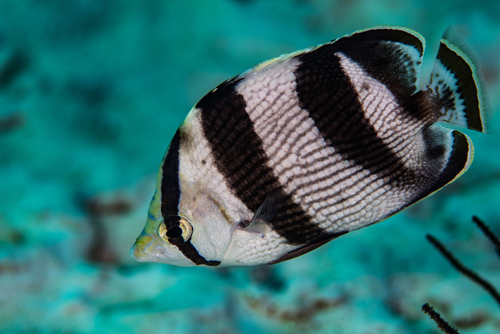
- Scientific name: Chaetodon striatus
- Diet: Carnivore
A sweet and friendly saltwater species, the Banded Butterfyfish is well-known as a great option for beginners that are looking to expand into a larger aquarium. They get along with other reef fish pretty well and are beautiful to look at.
These fish have disk-like bodies and small, short snouts. Their bodies are mostly brownish/yellow when they are young – before they gain their black and white stripes as they mature.
They are very vulnerable to larger predators and like to feed on small reef creatures like corals, anemones, and tube worms. They originate in the western Atlantic Ocean and will happily live independently or in pairs.
15. Horse Nose Cichlid
- Scientific name: Eretmodus cyanostictus
- Diet: Carnivore
Horse Nose Cichlids can be a slightly complicated tropical fish to care for, as they are a little delicate in their needs and only really get along with other fish from their home region: Lake Tanganyika in Africa.
The boldness of their dark stripes can vary, but they are almost always marked by nine vertical bars. They can also have a variety of different colors outside of their dark stripes, some even having notable red and orange coloration in their fins.
These fish mate for life so, though they can be kept on their own, they do like to have a partner. The tricky thing is making sure that any two that you put together actually get on, so it’s often safer to get a number of them at once and let them pair off naturally.
Summary
There are a lot of popular fish with black stripes out there to choose from, although some are certainly much easier to care for than others.
Many of the most dramatic and stunning examples of black-striped fish need quite a lot of room to breathe and quite specific conditions – like the many different kinds of majestic angelfish.
Some wonderful examples, however, are great for beginners: including the adorable Zebra Danio and the hardy Tiger Barb.
Frequently Asked Questions
How do I identify my fish?
If you don’t know what kind of fish you have, there are several different ways that you can identify them. Each species has distinct and unique characteristics that you can use to tell them apart, and there are even apps like FishVerify which can help to do the job for you.
Why do fish have stripes?
Striped markings can provide camouflage and help a fish to blend in, they can warn away potential predators by indicating that a fish is not safe to eat, and they can help fish to identify and communicate with one another within their social groups.

Ian Sterling, founder of Fishlab.com, began his aquarium journey over 30 years ago, driven by a deep fascination for fish and their diverse personalities. His website, Fishlab.com, is dedicated to making fishkeeping accessible and enjoyable, offering beginner-friendly guidance, expert insights, and a community for aquarists to connect and share experiences.

